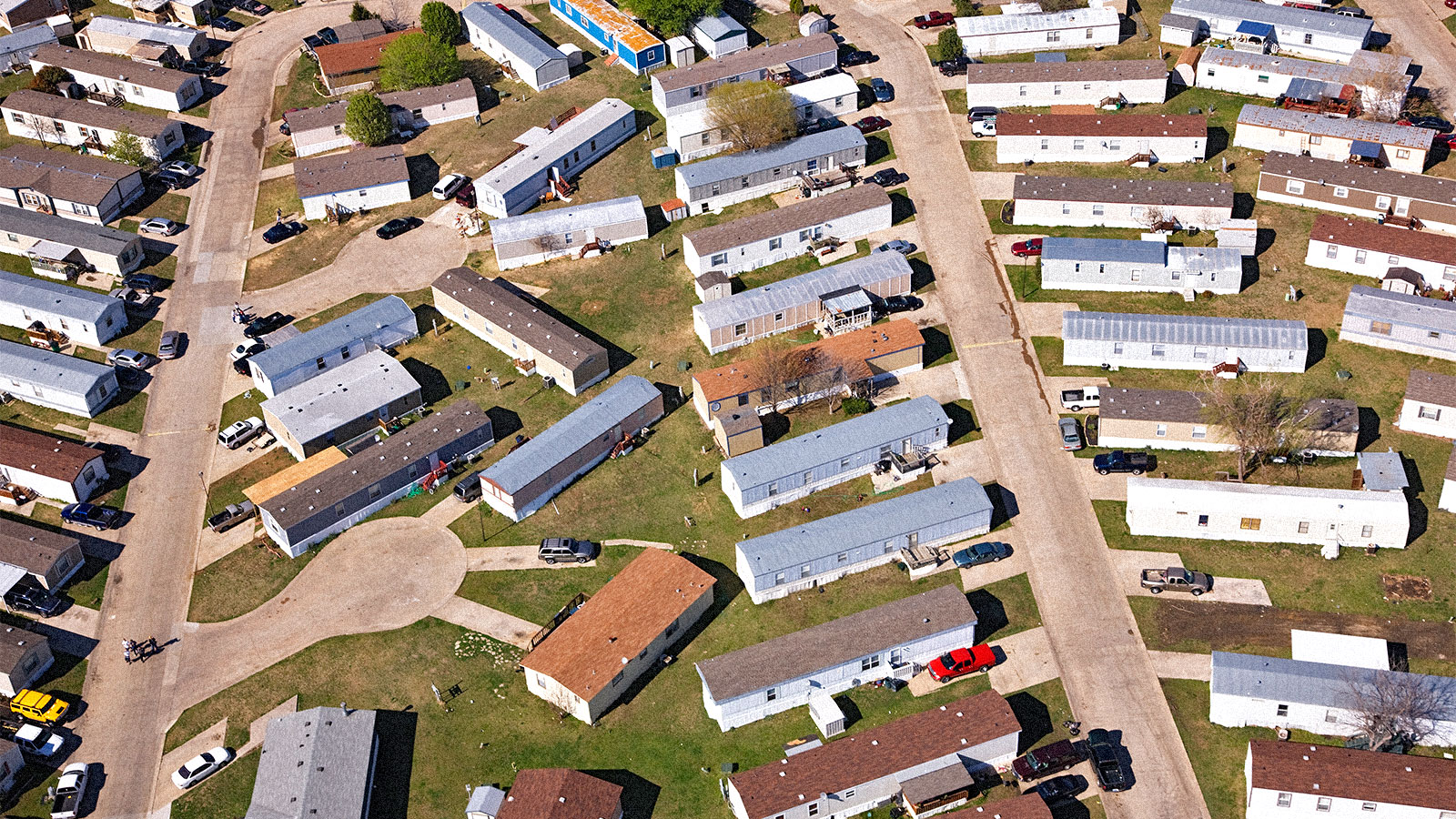At 3:30 in the afternoon on the first day of Texas’ winter freeze in February, the temperature plummeted to 20 degrees F inside Roxann Swoyer’s manufactured home — colloquially known as a mobile home — in the community of Hilltop, an unincorporated area outside of the Dallas-Fort Worth metropolitan area. The water she had been using to brush her teeth had frozen in its plastic bottles. The community’s water well had failed in an unrelated outage 10 days before the storm hit, and now her electricity was gone too.
For the first time in her 42 years living in the community, Swoyer was forced to abandon her home. Swoyer has stage-four cancer and hasn’t left her home for anything except doctors appointments since the start of the COVID-19 pandemic; but as temperatures continued to fall, she decided she had to leave, fearing she wouldn’t survive the cold. Despite her fear of contracting the virus, she went to stay at her son’s girlfriend’s apartment. That night, her neighbor’s trailer reached 2 degrees F, and he was forced to burn what he could in his fireplace to warm up his feet. “It was a living nightmare for everybody,” said Swoyer.
But the storm itself turned out to just be the beginning. When Swoyer returned to her home a week later, she found that her water and sewage systems had been almost completely destroyed by the storm — there were 19 breaks in the lines on her property alone. The lines to her washer and dryer had completely blown apart, and so had the sewage lines — raw sewage had spilled underneath her property. The damage took her son and brother 16 days to identify and fix, during which time she had no running water. The damage wasn’t just limited to Swoyer’s property — the community as a whole lacked running water for three days after the storm, on top of the outage preceding the storm.
They used bottled water to brush their teeth and rinse dishes, and water collected in tubs and buckets to flush toilets. Swoyer had to cancel doctor’s appointments and CAT scans — she didn’t want to show up filthy, she said. The storm, the damage, the days without water and power took a toll, especially for Swoyer, who knows her time is limited. “The cancer I have is not curable,” she said, “some days are tougher than others, but to have something like that thrown on top of it — all you can do is just sit and cry.”
Manufactured housing communities like Hilltop are home to 2.7 million households, and manufactured homes overall make up about 6.6 percent of the American housing stock. Manufactured home parks tend to house low- and fixed-income groups — often families, seniors, and recent immigrants — and in all comprise the largest unsubsidized type of affordable housing in the country. Despite this, they are often left behind in disaster recovery policy due to their unique split tenure: residents of manufactured housing communities often own their home, but rent the land that it sits on from a private landowner, and may have a water supply that is owned by a third private entity.
This split tenure arrangement, as well as an intersection of social and policy vulnerabilities that affect mobile homes, put them in a precarious position when disasters hit. Andrew Rumbach, assistant professor of landscape architecture and urban planning at Texas A&M University, studies how manufactured housing parks recover from disasters like last month’s freeze. “The Texas freeze really highlighted and emphasized the ways that these communities not only are more prone to suffering disasters but also struggle to recover afterwards more than other forms of housing in general,” said Rumbach. “Disasters are exceptional in one way, but in other ways they just emphasize everything about normal life. They make all the inequalities clear.”
One of these inequalities is the aging infrastructure, like water and sewage systems, often found in manufactured housing communities. Rumbach says that water outages like the one Swoyer experienced are not uncommon in manufactured housing communities following storm or flood events. In privately owned parks, the maintenance of a community’s water infrastructure is the responsibility of the owner of a private water company or the park’s landlord, who has a financial incentive not to spend money on upkeep. “In many cases, mobile home parks are seen as an excellent source of passive income, meaning that landlords explicitly look to pawn off the upkeep of the property on to tenants, on to the people who are renting those lots,” said Esther Sullivan, assistant professor of sociology at University of Colorado, Denver. “Any investment in the property takes away from their bottom line.”
The problems with water infrastructure aren’t just limited to storm events. A study by researchers at the University of California, Los Angeles, found that manufactured housing community residents in California are four times more likely to experience significant water outages than residents of other kinds of housing, and experienced a higher number of health violations in their water systems. That’s the case in Hilltop. Swoyer, who has lived in Hilltop since 1979, says that there have been shutoffs to the community’s water several times a year for as long as she can remember, for at least three or more days at a time. Whenever the weather got too hot, or too cold, or it rained too much, the water would go out. Even when the water is on, Swoyer says it will come out of the tap running red with rust at first. “We just got so used to it,” she said. “It’s just run down.”
Before the storm, Hilltop’s water infrastructure had long been owned by the utility company Abraxas, which was listed as a “serious violator” by the EPA, and has had 423 informal enforcement actions for 299 violations of the Safe Water Drinking Act since 2015, including for failing to alert consumers if there is a public health risk for drinking water, failing to monitor and report drinking water quality, and exceeding the maximum level of radionuclides, a contaminant linked to an increased risk of cancer.
On February 12, during the 10-day water outage at Hilltop and right before the freeze, Abraxas was acquired by another utility called Central States Water Resources, whose business model is to buy and repair failing utilities. A spokesperson for Central States Water Resources said the company agreed to the purchase knowing that one of the wells at Hilltop was not working — and the next day, the storm hit, worsening the problems of a system already in disrepair. The cold caused the service lines to freeze due to a lack of insulation, said the Central States Water Resources representative, and this combined with a power outage caused the other functional well to fail. “This system is a prime example of a water utility that has been chronically underinvested in and poorly managed,” said the spokesperson.
Central States Water Resources said that it took three days after the storm to get both wells in the community functional again, and that they sent around representatives door to door to let community members know what was going on and to provide bottled water. Swoyer, whose brother previously worked on the water system for Abraxas, says that she never saw any such outreach from the company after returning to her property.
If a park has a degraded water system, there’s often not much that residents can do. They can’t exactly pick up and leave — so-called “mobile homes” aren’t actually very mobile at all: Once they’re set down, they’re extremely expensive to move. More than 80 percent of mobile homes never move again after being put down on their foundation. This means, once set up in a park, residents are stuck there. “It’s a really tough position to be in,” said Rumbach, “There’s a lot of predatory stuff around mobile homes — people purchasing parks for profit. That’s basically the whole line — these people are a captured audience, they can’t leave.”
In addition to vulnerabilities in water infrastructure, manufactured housing communities have also long been marginalized in planning and zoning policy. According to Sullivan, “manufactured housing has faced over a century of exclusionary zoning and ordinances that place manufactured homes in inferior lands.” As a result, Sullivan says these communities are often located in storm and flood zones, and disproportionately exposed to disasters. They also tend to be isolated, fenced off, or pushed out into unincorporated areas outside of cities. According to Rumbach, “oftentimes, they’re sort of out of view by design.”
This isolation impacts how governments interact with manufactured housing communities — oftentimes, states have no idea how many of them there even are, or where they are located, making it difficult or impossible to send resources to communities after a disaster. Swoyer experiences the effects of this invisibility first hand — she says she feels left behind by the state and local government. “We[’ve] spent years out here, no one around, not really being claimed,” she said. “I think this state has failed us in a lot of ways, with COVID and what happened with the power.”
When it comes to recovery following a disaster, manufactured housing parks also face unique challenges. Because they don’t fit neatly into the categories of homeownership and rental, they are legally considered private businesses. As such, they aren’t often eligible for federal recovery funds, and even when they are eligible, it’s often the mobile home park owner that benefits — the people who live in the park themselves end up excluded from recovery funds and planning.
As climate change accelerates, and extreme weather events that produce disasters increase in frequency, the disparities faced by these communities are only going to become more apparent. And as of right now, there’s a fundamental disconnect between climate adaptation policies and manufactured housing. “We really need a federal disaster adaptation policy that does a better job of understanding what these places are and supporting residents in ways that doesn’t make them more vulnerable,” said Rumbach.
Sullivan says that regulating park owners more strictly is one path forward — requiring that they better maintain water and sewer infrastructure, for instance. But even more fundamental would be tackling the ownership structure of the parks. “To me a key issue with manufactured housing communities is that divided land ownership — that’s part of what creates a barrier to investment in climate mitigation,” said Sullivan. “If you target that ownership structure and think about nonprofit ownership, cooperative ownership, resident ownership of the land, it opens up many more possibilities for investment in the infrastructure of the community. You’re not counting on the goodwill of one landlord to get it done.”
In the meantime, without the support of the state or county government, residents like Swoyer are left to fend for themselves. “We just pull together and do what we have to do to make it,” she said. “We’re just the kind of people who roll with the punches. You knock me down, it might take me a minute to get up, but I’ll get back up.”



